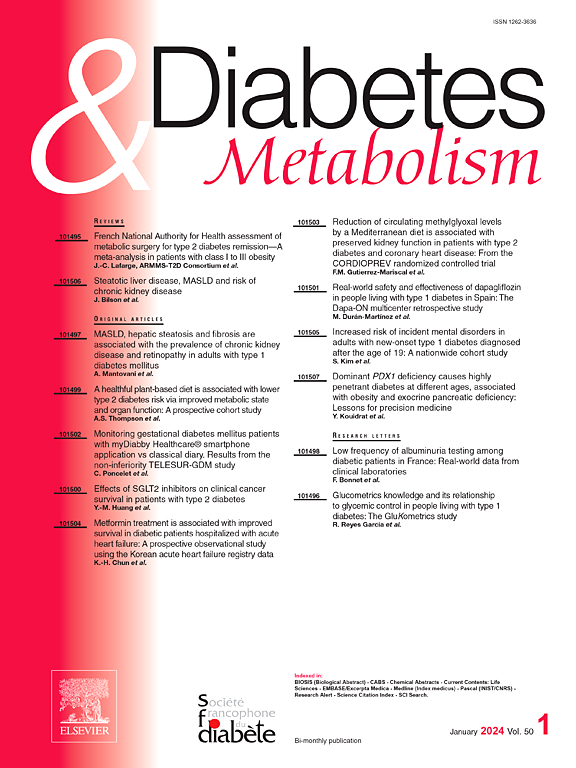癌症发生后吸烟行为改变对糖尿病发病率的影响:一项全国性队列研究。
IF 4.7
2区 医学
Q1 ENDOCRINOLOGY & METABOLISM
引用次数: 0
摘要
目的:吸烟和糖尿病(DM)增加癌症幸存者心血管疾病和全因死亡率的风险。已经观察到癌症幸存者患糖尿病的风险增加,吸烟是普通人群患糖尿病的一个重要的可改变的危险因素。因此,我们调查了癌症诊断后吸烟行为改变与癌症幸存者糖尿病发病率之间的关系。方法:本回顾性队列研究使用韩国国民健康保险系统数据库,纳入2010年至2016年新诊断的癌症患者。癌症诊断后的吸烟行为变化分为从不吸烟者、戒烟者、戒烟者、开始吸烟者和持续吸烟者。采用Cox回归分析研究吸烟行为改变与糖尿病发病率之间的关系。结果:在263940例癌症幸存者中,67.6%为从不吸烟者,16.0%为戒烟者,9.3%为戒烟者,1.0%为开始吸烟者,6.2%为持续吸烟者。在平均4.0年的随访期间,12,175名患者在癌症发展后被诊断为糖尿病。与从不吸烟者相比,戒烟者糖尿病发病率的校正危险比(95%保密区间)为1.06(1.00-1.13),戒烟者为1.45(1.35-1.54),初吸烟者为1.46(1.25-1.71),持续吸烟者为1.57(1.45-1.69)。结论:与从不吸烟者相比,在癌症诊断前后吸烟的癌症幸存者在癌症诊断后患糖尿病的风险增加。应建议癌症幸存者立即戒烟,并在癌症幸存者期间保持戒烟。本文章由计算机程序翻译,如有差异,请以英文原文为准。
Effects of smoking behavior change on diabetes incidence after cancer development: A nationwide cohort study
Aim
Cigarette smoking and diabetes mellitus (DM) increase risks of cardiovascular diseases and all-cause mortality in cancer survivors. An increased risk of DM incidence in cancer survivors has been observed and smoking is an important modifiable risk factor for DM development in the general population. Thus, we investigated the association between smoking behavior change after cancer diagnosis and DM incidence in cancer survivors.
Methods
This retrospective cohort study using the Korean National Health Insurance System database included patients with newly diagnosed cancers between 2010 and 2016. Smoking behavior changes after cancer diagnosis were categorized as never smoker, ex-smoker, quitter, smoking starter, and persistent smoker. The associations between smoking behavior changes and DM incidence in overall and specific cancers were investigated using Cox regression analyses.
Results
Of the 263,940 cancer survivors, 67.6 % were never smokers, 16.0 % were ex-smokers, 9.3 % were quitters, 1.0 % were smoking starters, and 6.2 % were persistent smokers. During a mean follow-up of 4.0 years, 12,175 patients were diagnosed with DM after cancer development. Compared to the never smokers, the adjusted hazard ratios (95 % confidential interval) of DM incidence were 1.06 (1.00–1.13) for ex-smokers, 1.45 (1.35–1.54) for quitters, 1.46 (1.25–1.71) for starters, and 1.57 (1.45–1.69) for persistent smokers.
Conclusion
Compared with never smokers, cancer survivors who engaged smoking at any point before or after cancer diagnosis showed an increased risk of DM incidence after cancer diagnosis. Cancer survivors should be advised to quit smoking promptly and to maintain abstinence throughout cancer survivorship.
求助全文
通过发布文献求助,成功后即可免费获取论文全文。
去求助
来源期刊

Diabetes & metabolism
医学-内分泌学与代谢
CiteScore
12.00
自引率
4.20%
发文量
86
审稿时长
13 days
期刊介绍:
A high quality scientific journal with an international readership
Official publication of the SFD, Diabetes & Metabolism, publishes high-quality papers by leading teams, forming a close link between hospital and research units. Diabetes & Metabolism is published in English language and is indexed in all major databases with its impact factor constantly progressing.
Diabetes & Metabolism contains original articles, short reports and comprehensive reviews.
 求助内容:
求助内容: 应助结果提醒方式:
应助结果提醒方式:


